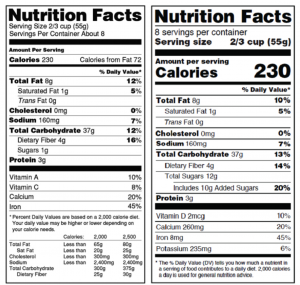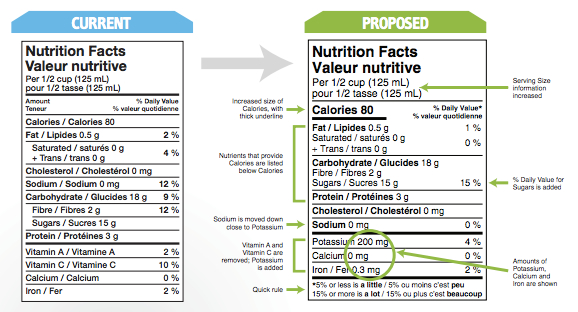The Nutrition Facts Table (NFT) in the USA is over 20 years old. On May 20, 2016, the FDA (U.S. Food and Drug Administration) introduced the new label to help consumers south of our border make informed choices about the food they buy and eat.

Here’s a brief summary of the key changes that will take effect by July 2018 on USA food labels:
1. Serving size and servings per container – are now highlighted in larger font and/or bold. Serving sizes have been updated.
LIKE: This underscores the importance of portion sizes.
DISLIKE: The serving sizes are based on the amounts of food and beverages that people are actually eating, not on the amounts that they should be eating. For example, the serving size of ice cream was previously ½ cup but is changing to 2/3 cup.
2. Calories – are now highlighted in extra large font (how can you miss it?)
LIKE: With a global obesity crisis, calories have become the simple currency of weight. We tend to underestimate the calories that we consume.
BUT…Calories does not tell the whole story. Remember to look at the bigger picture of nutrient density and food quality. A Greek yogurt parfait with nuts and fruit may have more calories that a donut – but which is the healthier choice?
3. Calories from fat – have been removed
LIKE: We know that the quality and type of fat is more important that the amount of fat.
4. Added sugars – makes a debut on the new USA NFT. The %DV (% Daily Value) is set at 50 grams.
LIKE: Consumers are hearing more about sugar and health. According to the FDA, research shows that it is difficult to meet nutrient needs while staying within caloric limits if you consume more than 10% of your total calories from added sugars. Disclosing the amount of added sugars on the label will help consumers better distinguish between the natural sugars versus the added sugars in the food.
5. Vitamin D and potassium – are required to be declared on the USA NFT, along with calcium and iron. For each of these, both the actual amount and the %DV amount are listed. Vitamins A and C are no longer mandatory, and can be listed on a voluntary basis.
LIKE: Since many of us are probably not getting enough Vitamin D, potassium, calcium and iron, these nutrients are of public health significance.
6. Footnote – is added to help put the %DV into context for consumers.
LIKE: The %DV is an easy way for consumers to determine whether the food has a little (less than 5% DV) or a lot (15% DV or more) of a nutrient.
The real question now is – will Health Canada follow suit with our NFT?
We’ll keep you posted as it happens!

